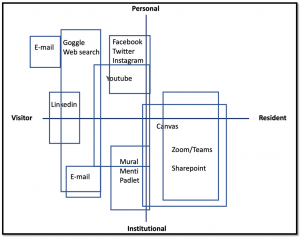No, It isn’t a typo. It’s DI as in digital identity. Who am I (currently) in the digital world, and what has characterised my journey so far?
One popular way to categorise people is Digital Natives and Digital Immigrants. Which category you belong to is determined by birth. Digital natives are born in the digital age and always had computers, video games and the Internet. Marc Prensky introduced this idea in 2001 (Prensky, Marc, 2001). However, it’s not helpful to categorise peoples engagement online – by age only. Scientific evidence shows no such thing as a digital native, and their alleged ability to multitask doesn’t exist (Kirschner & De Bruyckere, 2017).
The concept of Visitors – Residents
In 2011 a paper was published in First Monday (White & Le Cornu, 2011). It presented a concept of Visitors and Residents to, on a continuum, describe people’s online activities. Visitor mode is when you go online to use a tool for a specific purpose but not leaving any visible trace. On the other hand, a resident has a strong personal presence on the web and uses it to engage with others. Residents leave traces in the form of profiles, posts, photos on the Internet. The visitor – resident continuum was later developed by adding an axis of personal – institutional use (David S. White & Alison Le Cornu, 2017).
My Visitor – Resident map
I used this map to reflect on and create a snapshot of where my current practice stands. As can be seen, the personal – resident quadrant has almost no activity. My resident forms of engagement are linked primarily to my professional role as a teacher. However, even in the resident – institutional area, most of my activities and traces are within closed groups such as with students in Canvas, our Learning Management System (LMS).

I’m following lots of areas of interest on the web but rarely post anything. Even when I would like to post a comment on something, I usually want to think about it first, and then nothing gets posted. Sometimes I do ask a question, or for advice online on sites I trust. My personal side prefers to remain introverted as social interactions can leave me feeling drained.
So this blog is a step outside my comfort zone. I see value in engaging in collaborative learning and let’s see a few months from now how my digital identity has developed. My journey continues.
Read more:
David S. White & Alison Le Cornu. (2017). Using ‘Visitors and Residents’ to visualise digital practices. First Monday, 22(8). https://doi.org/10.5210/fm.v22i8.7802
Kirschner, P. A., & De Bruyckere, P. (2017). The myths of the digital native and the multitasker. Teaching and Teacher Education, 67, 135–142. https://doi.org/10.1016/j.tate.2017.06.001
Prensky, Marc. (2001). Digital Natives, Digital Immigrants. On the Horizon, MCB University Press, 9(5). https://marcprensky.com/writing/Prensky%20-%20Digital%20Natives,%20Digital%20Immigrants%20-%20Part1.pdf
White, D. S., & Le Cornu, A. (2011). Visitors and Residents: A new typology for online engagement. First Monday. https://doi.org/10.5210/fm.v16i9.3171
